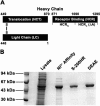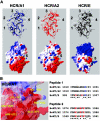Characterization of the antibody response to the receptor binding domain of botulinum neurotoxin serotypes A and E
- PMID: 16177380
- PMCID: PMC1230911
- DOI: 10.1128/IAI.73.10.6998-7005.2005
Characterization of the antibody response to the receptor binding domain of botulinum neurotoxin serotypes A and E
Abstract
Clostridium botulinum neurotoxins (BoNTs) are the most toxic proteins for humans. The current clostridial-derived vaccines against BoNT intoxication have limitations including production and accessibility. Conditions were established to express the soluble receptor binding domain (heavy-chain receptor [HCR]) of BoNT serotypes A and E in Escherichia coli. Sera isolated from mice and rabbits immunized with recombinant HCR/A1 (rHCR/A1) from the classical type A-Hall strain (ATCC 3502) (BoNT/A1) and rHCR/E from BoNT serotype E Beluga (BoNT/E(B)) neutralized the homologous serotype of BoNT but displayed differences in cross-recognition and cross-protection. Enzyme-linked immunosorbent assay and Western blotting showed that alpha-rHCR/A1 recognized epitopes within the C terminus of the HCR/A and HCR/E, while alpha-rHCR/E recognized epitopes within the N terminus or interface between the N and C termini of the HCR proteins. alpha-rHCR/E(B) sera possessed detectable neutralizing capacity for BoNT/A1, while alpha-rHCR/A1 did not neutralize BoNT/E. rHCR/A was an effective immunogen against BoNT/A1 and the Kyoto F infant strain (BoNT/A2), but not BoNT serotype E Alaska (BoNT/E(A)), while rHCR/E(B) neutralized BoNT/E(A), and under hyperimmunization conditions protected against BoNT/A1 and BoNT/A2. The protection elicited by rHCR/A1 to BoNT/A1 and BoNT/A2 and by rHCR/E(B) to BoNT/E(A) indicate that immunization with receptor binding domains elicit protection within sub-serotypes of BoNT. The protection elicited by hyperimmunization with rHCR/E against BoNT/A suggests the presence of common neutralizing epitopes between the serotypes E and A. These results show that a receptor binding domain subunit vaccine protects against serotype variants of BoNTs.
Figures




Similar articles
-
Development of an Equine Antitoxin by Immunizing the Halla Horse with the Receptor-Binding Domain of Botulinum Neurotoxin Type A1.J Microbiol Biotechnol. 2019 Jul 28;29(7):1165-1176. doi: 10.4014/jmb.1904.04027. J Microbiol Biotechnol. 2019. PMID: 31280529
-
Subunit vaccine efficacy against Botulinum neurotoxin subtypes.Vaccine. 2011 Oct 13;29(44):7688-95. doi: 10.1016/j.vaccine.2011.07.134. Epub 2011 Aug 10. Vaccine. 2011. PMID: 21839134 Free PMC article.
-
Enhancing toxin-based vaccines against botulism.Vaccine. 2018 Feb 1;36(6):827-832. doi: 10.1016/j.vaccine.2017.12.064. Epub 2018 Jan 4. Vaccine. 2018. PMID: 29307477 Free PMC article.
-
Mode of action of botulinum neurotoxins: current vaccination strategies and molecular immune recognition.Crit Rev Immunol. 2010;30(2):167-87. doi: 10.1615/critrevimmunol.v30.i2.50. Crit Rev Immunol. 2010. PMID: 20370628 Review.
-
Vaccines against botulism.Curr Opin Microbiol. 2012 Jun;15(3):317-24. doi: 10.1016/j.mib.2012.05.009. Epub 2012 Jun 12. Curr Opin Microbiol. 2012. PMID: 22694934 Review.
Cited by
-
Epitope mapping of botulinum neurotoxins light chains.Toxicon. 2012 Dec 1;60(7):1277-86. doi: 10.1016/j.toxicon.2012.08.002. Epub 2012 Aug 14. Toxicon. 2012. PMID: 22922018 Free PMC article.
-
Analysis of epitope information related to Bacillus anthracis and Clostridium botulinum.Expert Rev Vaccines. 2008 Feb;7(1):55-74. doi: 10.1586/14760584.7.1.55. Expert Rev Vaccines. 2008. PMID: 18251694 Free PMC article. Review.
-
Protective immunity against botulism provided by a single dose vaccination with an adenovirus-vectored vaccine.Vaccine. 2007 Oct 23;25(43):7540-8. doi: 10.1016/j.vaccine.2007.08.035. Epub 2007 Sep 5. Vaccine. 2007. PMID: 17897756 Free PMC article.
-
Immunization of mice with the non-toxic HC50 domain of botulinum neurotoxin presented by rabies virus particles induces a strong immune response affording protection against high-dose botulinum neurotoxin challenge.Vaccine. 2011 Jun 20;29(28):4638-45. doi: 10.1016/j.vaccine.2011.04.045. Epub 2011 May 5. Vaccine. 2011. PMID: 21549784 Free PMC article.
-
Recent Developments in Vaccine Design: From Live Vaccines to Recombinant Toxin Vaccines.Toxins (Basel). 2023 Sep 8;15(9):563. doi: 10.3390/toxins15090563. Toxins (Basel). 2023. PMID: 37755989 Free PMC article. Review.
References
-
- Baldwin, M. R., M. Bradshaw, E. A. Johnson, and J. T. Barbieri. 2004. The C-terminus of botulinum neurotoxin type A light chain contributes to solubility, catalysis, and stability. Protein Expr. Purif. 37:187-195. - PubMed
-
- Berzofsky, J. A., I. J. Berkower, and S. L. Epstein. 1999. Antigen-antibody interactions and monoclonal antibodies, p. 91-94. In W. E. Paul (ed.), Fundamental immunology, 4th ed. Lippincott-Raven, Philadelphia, Pa.
-
- Black, R. E., and R. A. Gunn. 1980. Hypersensitivity reactions associated with botulinal antitoxin. Am. J. Med. 69:567-570. - PubMed
-
- Byrne, M. P., and L. A. Smith. 2000. Development of vaccines for prevention of botulism. Biochimie 82:955-966. - PubMed
Publication types
MeSH terms
Substances
Grants and funding
LinkOut - more resources
Full Text Sources
Other Literature Sources
Medical
Molecular Biology Databases

